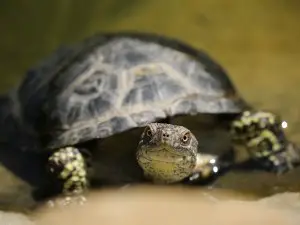
A turtle changing color or losing color will understandably be quite worrying to you, this can sometimes be normal and natural but it sometimes won’t be normal or natural.
This article looks into why your turtle is turning orange.
Table of Contents
Why is my turtle turning orange?
A color change, like a change to orange, in your turtle, is usually an indication that something is going on with the reptile.
Here is why your turtle is turning orange:
Your pet’s diet:
What you feed to your pet turtle can also have an effect on your pet’s appearance, the food that your reptile is eating may be what is turning your pet orange.
One thing that may be causing the orange color on your pet is eating shrimp in large quantities.
Another thing that may be causing your pet to turn orange is carrots staining the animal. The carrots that you’re feeding your pet may be breaking down in the enclosure’s water and staining your pet’s skin.
What to do:
If you’re feeding your pet large amounts of shrimp then cut down on the shrimp and see if your pet’s discoloration lessens.
Remove the carrots from your pet’s diet, and clean out the tank, then see if the animal’s skin color goes back to normal.
Old turtle losing color in its shell:
Another reason why your turtle may be turning orange may be because the reptile is getting older.
As your pet gets older the sun, or the light bulbs in the tank, bleach the shell making the dark shell of a turtle look orange or yellow.
This color change to orange usually happens in turtles with dark green, brown, or black shells. This color change is pretty much inevitable for virtually every species of turtle.
Not all turtle shells will change to orange, the animal’s habitat plays a role in what color the turtle’s shell will change to.
What to do:
This is quite normal for turtles and isn’t something that you should be concerned about.
As long as the animal is acting as it normally does, and isn’t showing signs of illness or distress, then your pet should be fine.
Older red-bellied turtle:
If you’re raising a red-bellied turtle, and its belly starts getting lighter and turning orange, then the animal’s belly is turning orange because it is getting older.
Not only can a turtle’s shell get lighter with old age its belly will also start to turn lighter with age too.
What to do:
If you know that your red-bellied turtle is older then you don’t have to worry, this is normal. As long as the animal is eating normally and isn’t in distress then your pet will be fine.
Illness:
Another reason why your pet’s shell or skin may be turning orange may be because your pet is ill.
A variety of conditions can cause the change in your pet’s coloring to orange including septicemia, a respiratory infection, an infected cut, or the animal may have an infection.
What to do:
There are a variety of illnesses that may be causing this color change, taking your pet to a vet, or better yet a reptile vet, is the recommended way to go.
The vet will examine your pet, may run some tests on it, and once diagnosed the vet will treat your little reptile if treatment options are available.
Your vet may recommend a change in your pet’s environment or a change to your pet’s diet.
If you enjoyed this article then you may also be interested in other turtle/tortoise related articles. Here are some articles that you may be interested in: Orange Spot On Tortoise Shell, Can Turtles Turn Around In Their Shell?, Why Is My Turtle Turning Orange And Red?, Baby Turtle Shell Color Fading To Yellow, Red-Eared Slider Orange Mouth, Turtle Shell Color Fading To Yellow

